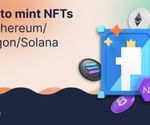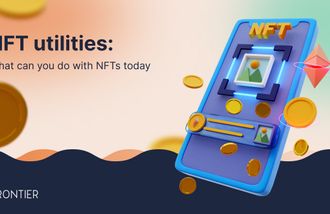

When CryptoKitties was launched in 2017, there was limited scope for NFTs utilities. Today, the NFT market grew from $200 million in total trading volume in 2020 to over $12 billion in Q1 of 2022. In this article, we will explore the various use cases of NFTs prevalent today as well as futuristic outcomes.
NFTs are cryptographically unique tokens stored on the blockchain representing digital assets. The immutability and transparency of the blockchain make it possible for anyone to easily authenticate the ownership of these digital assets on-chain. This ability to track and confirm provenance revolutionized the digital assets market. It provided a way to value digital assets like physical assets without worrying about piracy or replication.
NFTs created an environment that allowed creators to directly monetize their digital arts and reach their audience directly without intermediaries. This has created a thriving digital economy.
Image: BAYC Source: Opensea
However, since their emergence, people have struggled to understand what real-world use cases NFTs offer. This is because early NFT projects like the CryptoPunks and Bored Apes (BAYC) NFTs were mostly built around collecting a series of digital images and collectibles or trading in-game NFT items like with the CryptoKitties NFTs. These projects lacked any real-world utilities. But that is rapidly changing.
NFTs have evolved over time and are continuously finding unique use cases across various industries. Early projects like the BAYC which started off with no real utility are now building several utilities into the project such as offering exclusive rewards to holders, granting access into high-profile gated communities, and the Metaverse. NFTs are now more than just jpegs and memes.
NFTs in fashion
Digital fashion long preceded NFTs. People have had the ability to buy digital wearables and accessories for their characters and avatars in games like Roblox, The Sims, or virtual ecosystems like Second Life. But these experiences were gated and limited. NFT technology is revolutionizing the digital fashion industry. With NFTs, fashion transcends any one virtual ecosystem.
People can now purchase NFT wearables and use them across different digital platforms like attending various digital concerts etc. Moreso, the ability to verify asset ownership has paved the way for digital luxury goods to thrive.
This is why fashion giants like Nike, Adidas, Gucci, and Louis Vuitton are making major plays in the digital fashion industry.
Some highlights of the NFT revolution in digital fashion include augmented reality clothing. Brands are combining AR with NFT technology, to create garments that customers can collect, wear and trade. An example of this is the launch of the Nike Dunk Genesis Cryptokicks, a collection of 20,000 NFT sneakers, by Nike and RTFKT which owners can visualize in the real world through a Snapchat filter. Brands are also carrying out fashion shows in the Metaverse. Decentraland's Metaverse Fashion Week saw the participation of over 70 fashion brands including Tommy Hilfiger, Dolce & Gabbana, and Karl Lagerfeld.
NFTs in gaming
Gaming is unarguably the first industry NFTs found real utility. The ability to own in-game items tradable for real-world money has changed the gaming experience and introduced new gaming models such as play-to-earn. NFTs provide a way for game players to directly monetize their time. In-game NFTs allow for cross-platform playability, in-game trading, instant transactions, brand expansion into other industries like fashion, and other new revenue opportunities. A notable example is an effect Axie infinity is having on the economy of third-world countries like the Philippines.
The rise of NFT-based games has also led to the emergence of new sub-sectors such as crypto gaming guilds. Crypto gaming guilds such as YGG, Merit Circle, and others are organizations that facilitate participation in play-to-earn games by lowering the barrier to entry for new entrants. They purchase in-game NFT assets and lend them out to thousands of players to play and earn yields. With NFTs, value is equally distributed across various levels of participation in the gaming ecosystem.
NFTs as a social identity
Social media plays a huge role in our lives by acting as the greatest medium of expression of ourselves online. So, it is not surprising that most people spend so much time and effort on how they appear on social media. NFTs improve the existing social infrastructure by allowing users to own their identity instead of renting it to centralized platforms. The importance of digital identity is only growing and is evident in the increasing adoption of PFP NFTs like the BAYC, CryptoPunks, Moonbirds, etc.
Using NFTs as your profile picture on Twitter, Instagram or LinkedIn is a popular way for collectors to signal their status online. It is also a way to identify with a particular community and connect with people. The concept of secured digital identity in the Metaverse is made possible with NFTs.
This allows users to own and control who has access to their personal information. In this new dynamic, platforms and corporations will need to ask for permission to access user data, and in return, duly compensate users if they choose to grant them access.
NFTs in events and ticketing
NFT technology is increasingly being integrated into ticketing. Ticketing NFTs combines the best of paper tickets and QR codes. With NFTs, event organizers have more control over the distribution and logistics of tickets. They are able to mint a specific number of NFT tickets on their blockchain of choice, and can effectively track distribution which enables them to make informed business decisions like selling at a predetermined price or running an auction sale.
Ticketing NFTs offer flexibility that is not obtainable with paper tickets. They allow for effective community building of those with similar interests, as well as allow artists to reward event participants with limited-edition perks and incentives.
NFTs in real estate
The concept of digital property became popular with Metaverse projects such as Decentraland and The Sandbox. Digital NFT lands have become one of the most sought-after assets in recent times. This is because of the opportunities NFT virtual properties offer in the Metaverse such as advertising, hosting experiences, socializing, or gaming.
NFT utility is also stretching beyond real estate within digital ecosystems. They can also be used to represent physical properties. NFTs can be linked to essential details associated with any physical property such as map coordinates, prices, measurements, historical ownership, etc. This makes it practically impossible for malicious actors to tamper with property documents. Other real estate applications include storing land deed data and proof of ownership, tracking property value data, simplifying and speeding up transactions, and allowing smart contracts to complete sales more effectively without the risk of exposing sensitive data.
NFTs in supply chain/logistics
Usually, long and complex paper trails often accompany the transfer of ownership and transaction activity of a variety of items. This paper-based model is often susceptible to supply chain disruptions which can cost a business millions. For instance, in the automotive manufacturing industry, vehicles have hundreds of parts or more that come from different parts of the world. If there is a delay in obtaining any one of those items, the entire production can come to a halt. NFTs are being used in various industries to solve supply chain issues. Their digital footprint and data tracking capabilities make them ideal for reducing costs, eliminating bottlenecks, and creating greater visibility into supply networks.
NFTs allow manufacturers to create a digital identity for any item. Manufacturers can attach an item's real-world metadata such as name, current physical location, responsible party, container temperature, and a slew of other metrics. This data is automatically updated using time-stamping and geolocation technologies to give accurate and timely information on any item in the supply network. The transparency and immutability of the blockchain ensure the reliability and authenticity of supply chain data.
The supply chain utility of NFTs is rapidly being integrated into the fashion and luxury goods market to track high-end goods such as watches, handbags, and expensive jewelry. Also in the pharmaceutical industry, NFTs present a viable solution for counterfeit pharmaceuticals by streamlining the authentication process. In addition to being crucial in identifying fake drugs and prescriptions, NFTs also allow end users to have visibility into the conditions of each product on its supply chain journey, including storage locations, environmental factors like temperatures and humidity, and duration of storage. This effectively protects consumers from adulterated and harmful medications.
NFTs in music and entertainment
NFTs are also disrupting the music industry. The internet has made music readily available through streaming platforms like Spotify and others, which currently mop up the majority of the industry's total revenue. The problem here is that around 90% of all the streaming revenue goes to the top 1%. This makes it difficult for most artists to make a sustainable livelihood by streaming their music on these platforms. For example, Spotify pays a paltry $0.003-$0.005 per stream. This means that an artist needs their songs to be streamed around 16,670,000 times to make $50,000 off them.
NFTs cut out these streaming platforms and ensure that artists and music makers are fairly compensated for their work. By tokenizing music into NFTs, artists are able to directly benefit maximally from their work. With NFTs, they no longer need labels to put their music out, or streaming services to make money from their music. Songs, albums, music, lyrics, and soundbites can all be NFTs. Music NFT marketplaces such as Royal, Audius, and Sound.xyz are rapidly emerging to make it easier to tokenize and trade music NFTs.
NFTs also provide so much flexibility by allowing artists to continue to benefit from the resales of their NFTs on secondary markets. Furthermore, smart NFT technology also makes it possible to do cool things like combining music with digital art in JPEG and GIF formats, a PDF resource containing the lyrics to a song could also be included in music NFT.
NFTs in governance
NFTs are gradually finding use cases in decentralized governance within the crypto ecosystem. Decentralized governance is a very critical aspect of the crypto ecosystem. The ability to democratize decision-making and adopt a horizontal structure to organizational participation is what differentiates the crypto space from traditional institutions. Governance tokens are an effective tool for distributing power and rights among network or project participants through voting. But the current fungible token voting is susceptible to the risk of whale dominance and centralization. NFTs allow for the adoption of a better governance model via gNFTs.
The uniqueness of NFTs means that, unlike fungible tokens, 1 NFT does not equal any other NFT. This allows for a lot of creativity in governance design. With NFTs, capital is no longer a scarce resource, but a meaningful contribution. Another innovative concept being explored with NFTs in governance is the idea of non-transferable NFTs called SoulBound NFTs.

Conclusion
The massive interest in NFT use cases has led to a thriving digital economy. Creators, investors, and businesses are finding new real-world applications for assets, logistics, and sensitive data management using NFT technology. Despite the rapid upward trajectory in adoption, NFT utilities are still emerging with new applications being implemented every day. These new NFT use cases can provide new ways to identify, track and simplify our day-to-day activities.
As the digital ecosystem continues to grow with the rapid transition into the Metaverse, NFTs will continue to play a major role in tracing ownership, digital identity, and social status, defining properties and building strong digital networks and communities. And DeFi front-runner projects like Frontier will continue to provide the necessary tools for users to collate and manage their NFT activities.

Head, Communications & Content



